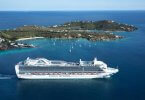Undersea experiences reaching new depths

More cruise lines than ever are making it easy for passengers not only to speed over the water in their ships but to experience the underwater environment that those ships are passing through.
The silent depths turn out not to be so silent on an increasing number of ships equipped with hydrophones to pick up under-ocean sounds. The sights of the briny deep are also on display through cruise ships that either offer a window to the marine blue or a live feed on a video screen from some sort of underwater camera.
Many of the submarine experiences are on small ships that can get up close to coral reefs and into coves and fjords that offer intimate views of marine mammals such as dolphins, whales or seals.
One cruise line is doing excursions on an actual submarine.
Here are a few ways to take in the world beneath the waves.
Hurtigruten

At Hurtigruten, drones are not just for flying. The Norwegian coastal carrier has teamed up with another Norwegian concern and will equip its next generation of expedition ships with underwater drones.
When the Roald Amundsen launches next summer, it will carry the latest version of a seagoing drone developed by Blueye Robotics.
The Trondheim, Norway, company is the maker of the Blueye Pioneer, a 15-pound, waterproof, hydrodynamic camera with stabilizers and four thrusters that enable it to maneuver even in strong currents.
The $3,500 drone is powered by a battery with a two-hour charge and is tethered by a thin, 250-foot cable to a surface buoy that transmits video, which then can be picked up via WiFi on a guest’s tablet or smartphone.
Multiple smartphones can connect to the same signal for a shared experience.
Hurtigruten plans to sail the Roald Amundsen and a sister ship, the Fridtjof Nansen (both named for Norwegian explorers), in Antarctica, the Northwest Passage, Svalbard, Greenland and the Norwegian coast, remote areas where the territory undersea is truly ripe for passenger discovery.
“With underwater drones on our ships, we can take our guests to areas less explored than the surface of Mars,” Hurtigruten CEO Daniel Skjeldam said.
Lindblad
Lindblad Expeditions brings under-ocean sounds to passengers via hydrophones: underwater sound amplifiers that can pick up communications passed between marine mammals like whales or sea lions up to three miles away.
In addition, Lindblad ships employ an underwater diving specialist with a high-definition camera who brings back images and videos for display in the ship’s lounge, which is designed so that all guests can be comfortably seated and view TV monitors around the room.
Lindblad ships also feature a sled-like remote operating vehicle, deployed by the undersea specialist and expedition diver from a Zodiac, which is capable of diving to depths of 1,000 feet and bringing back videos of sights beyond the range of the diving specialist.
All of these capabilities are available on the National Geographic Quest, Lindblad’s newest ship, which was launched in June and will be sailing in Panama and Costa Rica this winter.
Ponant

Also new underwater is the Blue Eye lounge, which will debut on Ponant’s newest class of ship, beginning with the 184-passenger Le Laperouse next summer. The signature features of the lounge are subsurface observation windows, one on each side of the ship, which offer views of what’s going on outside the hull.
The lounge is also equipped with digital screens that can project live images filmed by three underwater cameras.
Like Lindblad, Ponant’s Blue Eye will employ hydrophones to pick up sounds as well as the sights available through the windows.
“Body listening sofas” will discreetly vibrate in unison with the streaming aquatic acoustics.
Underwater floodlights will run most of the length of the ship, illuminating the view from the Blue Eye.
Navin Sawhney, CEO of the Americas for Ponant, said some of the inspiration for the Blue Eye was taken from the Jules Verne science fiction novel “20,000 Leagues Under the Sea,” in which Captain Nemo pilots a submarine called the Nautilus.
In keeping with the sleek, modern design of Ponant’s fleet, the Blue Eye will be somewhat futuristic-looking, dimly illuminated in a blue glow with curving white contemporary sofas tiered in banks around the observation portals.
Crystal
One of the coolest ways to sink beneath the surface on a cruise ship is in the minisubmarine carried on Crystal Cruises’ expedition yacht, the Crystal Esprit.
Outfitted for two passengers plus a pilot, the bubble-like, acrylic cabin gives passengers an immersive view of the sea at depths of up to 3,280 feet. The submersible won’t win any races, however, with a cruising speed of 3 knots (a little more than 3 mph).
Passengers are ferried on a Zodiac a short distance to board the submarine through its top hatch. The experience is sort of like scuba diving in a high-tech lounge chair. Crystal offers 30-minute tours on what it has dubbed the Genting Explorer for $599 per person.
Royal Caribbean
Another way to see the underwater world from a cruise ship is to don a snorkel mask or scuba gear and plunge in.
Many lines offer certified scuba divers a chance to dive on excursions. But Royal Caribbean International takes it a step further, offering ships with PADI (Professional Association of Diving Instructors) Five Star Dive Centers aboard, enabling guests to become certified scuba divers as part of their cruises.
Introduced last year on 10 Royal ships, the scuba course includes four open-water dives in two ports of call, in either the Caribbean or South America. The cost starts at $599 per person.







